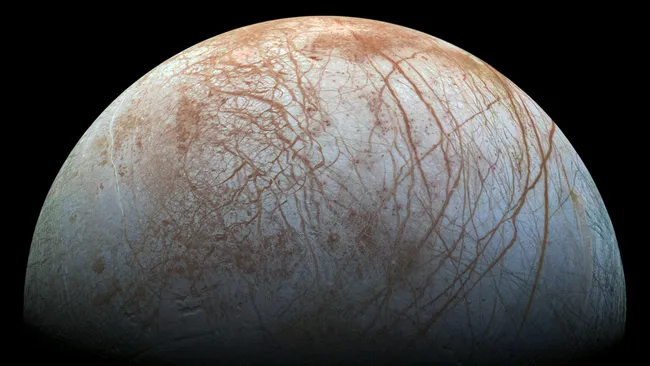NASA’s Juno Spacecraft Detects Indications of Activity on Jupiter’s Frozen Moon Europa
The close approach to reveal possible proof of recent surface activity in the Jovan system.
In 2022, NASA’s Juno spacecraft conducted a close flyby of Europa, one of Jupiter’s fascinating moons. During this flyby, Juno’s Stellar Reference Unit (SRU), a star camera used for attitude determination, captured high-resolution images of Europa’s surface illuminated by sunlight reflected off Jupiter, also known as Jupiter-shine.
The SRU image obtained during the flyby has been thoroughly examined and discussed in an article published in the journal JGR Planets on December 22, 2023. This image reveals a peculiarly-shaped region on Europa’s icy surface, measuring approximately 23 miles by 42 miles (37 kilometers by 67 kilometers), resembling the appearance of a platypus. It consists of a “body” section in the north and a “bill” section in the south, connected by a cracked neck-like formation. Within both areas, there are sizable ice blocks, each measuring around 0.62 miles (1 km) in diameter, casting shadows.

By comparing these high-resolution images with similar ones taken by NASA’s Galileo spacecraft, which studied Jupiter from 1995 to 2003, scientists have noticed potential changes in the southern part of the “platypus” region. These changes suggest that alterations may have occurred on Europa’s surface since the time of the Galileo mission.
However, the team of researchers, led by Heidi N. Becker from NASA’s Jet Propulsion Laboratory (JPL), cautions that the evidence is not conclusive due to disparities in imaging quality and conditions between the two missions.Furthermore, the 2022 image also reveals nearby low-albedo deposits, which could be linked to subsurface liquid water, according to the researchers. These dark stains may be associated with plumes that are believed to eject water into space.
Although not definitive, the Platypus presents an intriguing opportunity for upcoming missions like NASA’s Europa Clipper and Europe’s JUICE to explore and potentially validate ongoing surface activity on Europa.JUICE was launched in April of 2023 and is expected to reach Jupiter in December 2031. As for Europa Clipper, it is scheduled to be launched on Oct. 6 this year using a Falcon Heavy rocket.
This article is republished from space.com under a Creative Commons license. Read the original article.
Do not forget to share your opinion with us to provide you with the best posts !



0 Comments